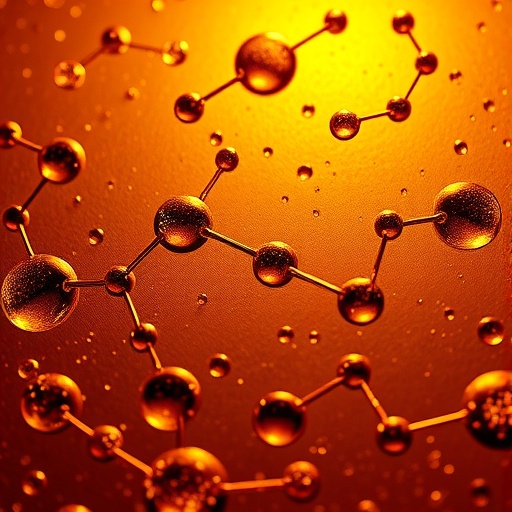In recent years, the urgent need for sustainable energy solutions has catalyzed extensive research into hydrogen production methods. Among the various technologies under consideration, the hydrogen evolution reaction (HER) stands out for its potential to generate clean hydrogen fuel. Researchers are relentlessly exploring new materials and methods to enhance the efficiency and viability of this process. A groundbreaking study recently published in Ionics presents a significant advancement in this realm: the development of a palladium-gold (Pd-Au) bimetallic thin film on a polyaniline-decorated graphite substrate. This innovative approach promises to transform the landscape of hydrogen generation under acidic conditions.
The new research, conducted by a team led by M.B. Islam, delves into the interactions and performance characteristics of the Pd-Au bimetallic system. Prior studies have documented the promising catalytic properties of both palladium and gold individually; however, their combination could yield synergistic effects conducive to enhancing HER performance. The integration of these metals creates a composite that allows for improved electron transfer and facilitates reaction kinetics, which are critical factors in accelerating hydrogen generation.
The introduction of a polyaniline-decorated graphite substrate serves multiple purposes in this study. First, polyaniline is known for its excellent electronic conductivity, which can bolster the overall efficiency of the bimetallic catalyst. By providing a stable and conductive platform, the polyaniline layer enhances the distribution and accessibility of the catalytic sites. Together with the graphite substrate, this composite material not only combines the advantageous properties of each component but also represents an innovative direction in the quest for effective and affordable electrochemical catalysts.
Acidic conditions typically pose significant challenges for hydrogen production due to increased corrosion, which adversely affects catalyst stability and longevity. The researchers’ focus on the Pd-Au bimetallic system under these harsh environments demonstrates their commitment to overcoming these limitations. The study details how the unique characteristics of the Pd-Au alloy contribute to better operational stability, making it a viable candidate for real-world applications where acidic solutions are prevalent.
Leveraging sophisticated fabrication techniques, the team meticulously crafted thin films of the Pd-Au alloy. They utilized sputter deposition, a technique that enables the precise control of layer thickness and composition, ensuring optimal performance characteristics. Characterization methods, including scanning electron microscopy (SEM) and X-ray diffraction (XRD), were employed to scrutinize the structural integrity and morphology of the films, providing valuable insights into the relationship between form and function.
Hydrogen production is not merely a disciplinary challenge; it intertwines with ecosystem preservation, energy transition, and economic viability. The implications of the study extend beyond theoretical discussions—they pose a solution that can be scaled for industrial applications. Policymakers and energy producers may take keen interest in the findings, motivating further investments in hydrogen infrastructure and fueling a shift toward cleaner energy sources.
Furthermore, the study details experiments that quantify the catalyst’s performance through electrochemical assessments. With the utilization of techniques like linear sweep voltammetry (LSV) and electrochemical impedance spectroscopy (EIS), the researchers delineate how the Pd-Au bimetallic thin film significantly enhances HER activity compared to pure metals. Such meticulous data analysis unveils the catalytic mechanisms and efficiency levels, providing a compelling narrative for the future of hydrogen energy.
In light of the findings, the Pd-Au bimetallic thin film represents a paradigm shift in catalyst design—prioritizing sustainability without sacrificing performance. The research underscores the importance of multi-metal systems and composite materials in optimizing chemical reactions, paving the way for more efficient catalysts in energy applications.
As the world accelerates towards green technology and decarbonization, the research team anticipates that their innovations will inspire further exploration into novel catalytic systems. The distinct advantages of these thin films could lead to their integration into commercial hydrogen production setups, potentially aiding in the broader ambition of achieving net-zero emissions.
The implications of this study transcend the findings alone; they encapsulate a holistic approach to energy utilization, considering the full lifecycle of materials and their environmental impact. By prioritizing materials that promote effective energy production, the researchers advocate for a shift toward more thoughtful and sustainable engineering practices.
In conclusion, the advancement represented by the Pd-Au bimetallic thin film offers a promising chapter in the ongoing saga of hydrogen research. The meticulous exploration of its properties evidences not only scientific rigor but also the potential for practical application in an energy-hungry world. As countries and industries grapple with the pressing realities of climate change and energy scarcity, such innovations may well illuminate the pathway toward sustainable hydrogen solutions, encapsulating the essence of modern scientific inquiry.
The results of this study advocate for continued investment in research and development of bimetallic systems while aiming for a broader impact through educational and regulatory measures. Greater collaboration among academic, governmental, and industrial entities will be essential in catalyzing the transition toward a hydrogen economy, underscoring the relevance of research in answering some of the most challenging dilemmas of our time.
The year 2025 may mark a pivotal moment in the history of energy technology, as innovations like the Pd-Au bimetallic thin film could significantly influence future strategies in energy sustainability. The momentum granted by such studies, paired with global initiatives targeting decarbonization, positions the hydrogen solution as not just a dream but as an achievable goal within our reach.
Subject of Research: Hydrogen evolution reaction (HER) efficiency using Pd-Au bimetallic thin film catalyst.
Article Title: Pd-Au bimetallic thin film on polyaniline decorated graphite substrate for efficient hydrogen evolution reaction under acidic condition.
Article References:
Islam, M.B., Islam, M.N., Ahmed, J. et al. Pd-Au bimetallic thin film on polyaniline decorated graphite substrate for efficient hydrogen evolution reaction under acidic condition. Ionics (2025). https://doi.org/10.1007/s11581-025-06831-y
Image Credits: AI Generated
DOI: 14 November 2025
Keywords: Hydrogen evolution, Pd-Au bimetallic catalyst, polyaniline, acidic conditions, sustainable energy, electrochemistry, thin film coating, energy technology, green hydrogen, advanced materials.
Tags: acidic conditions in electrochemistryadvanced materials for hydrogen generationcatalytic properties of palladium and goldclean hydrogen fuel generationelectron transfer in hydrogen productionhydrogen evolution reaction enhancementsHydrogen Productioninnovative approaches to renewable energy technologypalladium-gold bimetallic thin filmpolyaniline-decorated graphite substratesustainable energy solutionssynergistic effects in catalyst performance





